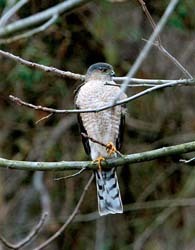 Hawks, Falcons and Accipiters, Oh, My!
Hawks, Falcons and Accipiters, Oh, My!
The name hawk derives from the Teutonic root hab, meaning "to seize or take hold." The family name Accipitridae is from the Latin word accipere meaning, "to take or seize." Both refer to the strong grasping ability these birds of prey share.
In the fall, there is a huge migration of raptors. Raptor migration is one of the most thrilling birding events to observe. Large groups or "kettles" of raptors may contain up to 1,000 birds. Flocks of hawks soaring on thermals look like steam rising from a "kettle," hence the name.
Migrating raptors include most falcons and ospreys, Red-tailed, Rough-legged, Swainson's Hawks and Turkey Vultures. Swainson's Hawks are the long-distance champions of the North American hawks, traveling as far south as the Argentina's Pampas.
Many raptors stay in our area throughout the year. The Northern Goshawk drops south from Canada for the winter months.
Merlin, a small falcon, have long, graceful wings for the power and speed they utilize in the capturing small birds in urban areas in winter.
Accipiters, like the Sharp-shinned Hawk, have short wings and long tails that aid them in the twisting and rapid turning flight needed to chase down their prey in dense woodland and scrub habitats.
The following are longevity records for some banded hawks in the wild:
- Red-tailed Hawk over 28 years
- Swainson's Hawk over 19 years
- Rough-legged Hawk over 17 years
- Sharp-shinned Hawk over 19 years
- Cooper's Hawk over 20 years
(Kathy and her husband, John, own and operate the Wild Birds Unlimited, located at 111 S. 24th Street West, Billings and at www.wbu.com/billings.)

